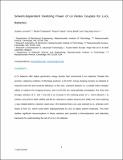| dc.contributor.author | Leverick, Graham M. | |
| dc.contributor.author | Tułodziecki, Michał | |
| dc.contributor.author | Tatara, Ryoichi | |
| dc.contributor.author | Bardé, Fanny | |
| dc.contributor.author | Shao-Horn, Yang | |
| dc.date.accessioned | 2021-10-13T17:36:36Z | |
| dc.date.available | 2021-10-13T17:36:36Z | |
| dc.date.issued | 2019-04 | |
| dc.date.submitted | 2018-10 | |
| dc.identifier.issn | 2542-4351 | |
| dc.identifier.uri | https://hdl.handle.net/1721.1/132951 | |
| dc.description.abstract | Li-O₂ batteries offer higher gravimetric energy density than commercial Li-ion batteries. Despite this promise, catalyzing oxidation of discharge products, Li₂O₂ and LiOH, during charging remains an obstacle to improved cycle life and round-trip efficiency. In this work, reactions between LiI, a soluble redox mediator added to catalyze the charging process, and Li₂O₂ and LiOH are systematically investigated. We show that stronger solvation of Li⁺ and I⁻ ions led to an increase in the oxidizing power of I₃⁻, which allowed I₃⁻ to oxidize Li₂O₂ and LiOH in DMA, DMSO, and Me-Im, whereas in weaker solvents (G4, DME), the more oxidizing I₂ was needed before a reaction could occur. We observed that Li₂O₂ was oxidized to O₂, whereas LiOH reacts to form IO⁻, which could either disproportionate to LiIO₃ or attack solvent molecules. This work clarifies significant misconceptions in these reactions and provides a thermodynamic and selectivity framework for understanding the role of LiI in Li-O₂ batteries. | en_US |
| dc.publisher | Elsevier BV | en_US |
| dc.relation.isversionof | http://dx.doi.org/10.1016/j.joule.2018.12.014 | en_US |
| dc.rights | Creative Commons Attribution-NonCommercial-NoDerivs License | en_US |
| dc.rights.uri | http://creativecommons.org/licenses/by-nc-nd/4.0/ | en_US |
| dc.source | Prof. Shao-Horn | en_US |
| dc.title | Solvent-Dependent Oxidizing Power of LiI Redox Couples for Li-O2 Batteries | en_US |
| dc.type | Article | en_US |
| dc.identifier.citation | Leverick, Graham M. et al. "Solvent-Dependent Oxidizing Power of LiI Redox Couples for Li-O2 Batteries." Joule 3, 4 (April 2019): 1106-1126. © 2018 Elsevier Inc. | en_US |
| dc.contributor.department | Massachusetts Institute of Technology. Department of Mechanical Engineering | en_US |
| dc.contributor.department | Massachusetts Institute of Technology. Research Laboratory of Electronics | en_US |
| dc.contributor.department | Massachusetts Institute of Technology. Department of Materials Science and Engineering | en_US |
| dc.relation.journal | Joule | en_US |
| dc.eprint.version | Author's final manuscript | en_US |
| dc.type.uri | http://purl.org/eprint/type/JournalArticle | en_US |
| eprint.status | http://purl.org/eprint/status/PeerReviewed | en_US |
| dspace.date.submission | 2020-09-22T20:53:49Z | |
| mit.journal.volume | 3 | en_US |
| mit.journal.issue | 4 | en_US |
| mit.license | PUBLISHER_CC | |
| mit.metadata.status | Complete | en_US |
